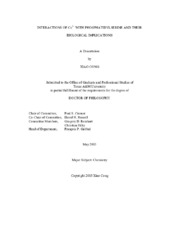| dc.contributor.advisor | Cremer, Paul S | |
| dc.contributor.advisor | Russell, David H | |
| dc.creator | Cong, Xiao | |
| dc.date.accessioned | 2015-09-21T16:54:55Z | |
| dc.date.available | 2017-05-01T05:35:40Z | |
| dc.date.created | 2015-05 | |
| dc.date.issued | 2015-04-24 | |
| dc.date.submitted | May 2015 | |
| dc.identifier.uri | https://hdl.handle.net/1969.1/155048 | |
| dc.description.abstract | Phosphatidylserine (PS) lipids in cell membranes play significant roles in cell apoptosis, blood clotting and neurodegenerative disorders such as Alzheimer’s disease (AD). A novel fluorescence quenching assay based on lipid bilayer-coated microfluidic platform was developed to investigate the interactions of PS, Cu2+ and PS-related proteins on membranes. PS in supported lipid bilayers (SLBs) was found to bind Cu2+ and the resulting Cu(PS)2 complex could quench a broad spectrum of lipid-bound fluorophores in a reversible and pH-dependent fashion.
This quenching assay was subsequently combined with other spectroscopy techniques to explore how Cu2+-binding affinity changes as a function of PS surface density. The apparent binding affinity of Cu2+ to PS got enhanced by about five orders of magnitude as the PS density in SLBs was increased from 1.0 to 20 mol %. Despite the effect of binding valency change from monovalent to bivalent, this binding enhancement was primarily attributed to the greatly amplified Cu2+ concentration in the double layer of the surface with a high PS density, since Cu2+-binding preserves the surface charges.
Cu2+-PS interactions have numerous biological implications under specific physiological or pathological conditions. Herein two typical examples were investigated. First one involves the interactions of β-amyloid peptides (Aβ), Cu2+ and lipid membranes. Aβ is an important biomarker of Alzheimer’s disease (AD) while Aβ-binding of transition metal ions can promote its pathological assembly. We applied our fluorescence assay and mass spectrometry (MS) to mimic how Aβ acquires Cu2+ from cell membranes in AD brains where copper level is generally reported to be depressed. The Cu2+ detachment by Aβ was detected by monitoring the recovery of the fluorescent signal quenched by Cu(PS)2 complex. This Cu2+ transfer behavior can be confirmed by MS detection of different complexes. The results could assist clarifying the membrane-related neurotoxicity of Aβ and copper homeostasis at pathological conditions. The combination of fluorescence and MS can be further applied in investigations of other Cu2+-mediated interactions between proteins and membranes. Another biological implication is about the effect of Cu2+-PS binding on lipid oxidations. With PS in vesicles, the oxidation of surrounding unsaturated phosphatidylcholine (PC) lipids was inhibited, which implies that PS in the membranes might protect other lipids against the Cu2+-catalyzed oxidation. | en |
| dc.format.mimetype | application/pdf | |
| dc.language.iso | en | |
| dc.subject | Lipid membrane | en |
| dc.subject | Transition metal ions | en |
| dc.subject | Ligand-receptor Interaction | en |
| dc.subject | Fluorescence | en |
| dc.subject | Alzheimer's Disease | en |
| dc.subject | Lipid oxidation damage | en |
| dc.title | Interactions of Cu2+ with Phosphatidylserine and Their Biological Implications | en |
| dc.type | Thesis | en |
| thesis.degree.department | Chemistry | en |
| thesis.degree.discipline | Chemistry | en |
| thesis.degree.grantor | Texas A & M University | en |
| thesis.degree.name | Doctor of Philosophy | en |
| thesis.degree.level | Doctoral | en |
| dc.contributor.committeeMember | Reinhart, Gregory D | |
| dc.contributor.committeeMember | Hilty, Christian | |
| dc.type.material | text | en |
| dc.date.updated | 2015-09-21T16:54:55Z | |
| local.embargo.terms | 2017-05-01 | |
| local.etdauthor.orcid | 0000-0002-8551-2595 | |


